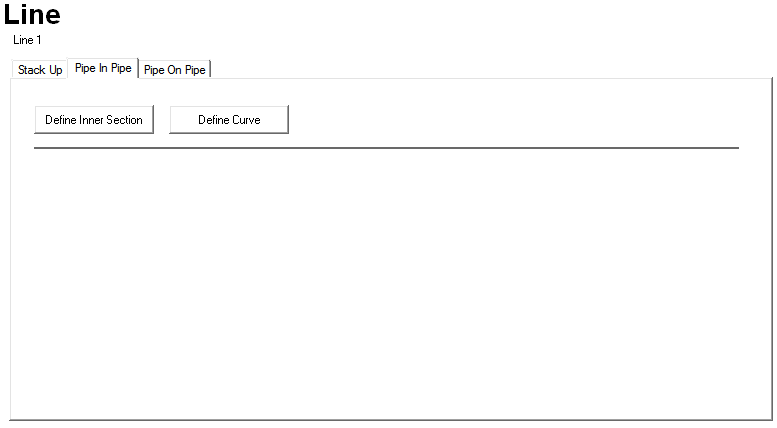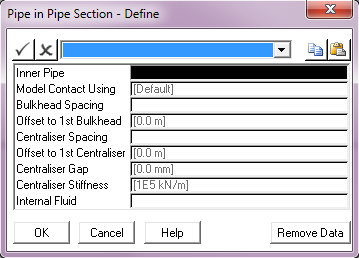You use the Pipe In Pipe tab to define an inner pipe that is contained within the pipeline that is defined by the Line component. The inner pipe runs through the entire pipeline stack up.

Pipe In Pipe Tab
Note
This tab is not available in PipeLay Starter Edition
To specify the properties of the inner pipe, you click on the Define Inner Section button. The Pipe in Pipe Section – Define dialog is displayed, as shown in the figure below.

Pipe In Pipe Section – Define
You use the Inner Pipe drop-down list to select a pipe section to use as the inner pipe. The Internal Fluid option allows you to define an internal fluid for the inner pipe. The remaining options on this dialog define aspects of the interaction between inner and outer pipes. These interactions fall into three categories; bulkheads, centralisers and free movement.
A bulkhead is where the two pipes are rigidly connected or joined together. You can define the locations of bulkheads using the Offset to 1st Bulkhead and Bulkhead Spacing inputs. The Offset to 1st Bulkhead input defines the distance to the first bulkhead from the start of the inner and outer pipe sections. The Bulkhead Spacing input allows you to locate bulkheads at a constant spacing from the first bulkhead over the remainder of the lines.
A centraliser is defined by a linear Centraliser Stiffness value. PipeLay offers the option to define a centraliser gap, which is the gap between the outer edge of the centraliser and the inner surface of the outer pipe. This defaults to 0, meaning that the centraliser extends all the way from the outer surface of the inner pipe to the inner surface of the outer pipe. You define the locations of centralisers using the Offset to 1st Centraliser and Centraliser Spacing inputs. The Offset to 1st Centraliser input defines the distance to the first centraliser from the start of the inner and outer pipe sections. The Centraliser Spacing input allows you to locate centralisers at a constant spacing from that first centraliser over the remainder of the lines.
Except where the pipes are constrained by bulkheads or centralisers, inner and outer pipes are free to move radially relative to one another. However, PipeLay must ensure that when inner and outer pipes come into contact, there is no penetration of the outer by the inner. PipeLay achieves this by using special non-linear connections. These connections have a very low stiffness when the sections are in their respective un-deformed positions, but the stiffness increases exponentially as the gap between sections approaches zero, to provide a simple but robust contact model. The Model Contact Using drop-down list provides the option to define this non-linear connection stiffness curve. The drop-down list contains the options Default or User Defined Curve, as shown in the figure below.
Model Contact Using Options
If you select the Default curve, PipeLay automatically determines the curve for you. The Default option is adequate in the majority of pipe in pipe models. Alternatively, you can select User Defined Curve to define a curve yourself. To define the curve, you click on the Define Curve button in the Pipe in Pipe tab to display the dialog shown below.

Pipe In Pipe Contact Curve – Define